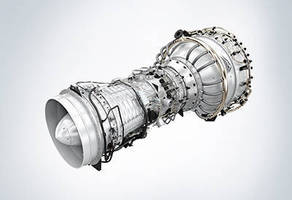Gas Turbine targets oil and gas industry.
Share:
Press Release Summary:

Featuring aero-derivative technology, Model RB211-GT30 drives 2-pole AC generator at either 60 Hz or 50 Hz with no need for gearbox. Lightweight gas turbine is designed specifically for offshore duty, with 3-point base mount and torque tube design. With rail system built in, complete turbine can be removed from either side of package and exchanged in less than 24 hours. Auxiliary systems facilitate maintenance access and maximize online maintenance while unit is running.
Original Press Release:
Siemens Presents New Lightweight Aero-derivative Gas Turbine for the Oil and Gas Industry
Erlangen,--Â
Industrial RB211-GT30 optimized for the needs of the oil and gas industry
New gas turbine package design: 30 percent smaller and lighter
Core engine drives AC generator at either 60 Hz or 50 Hz with no need for gearbox
With the Industrial RB211-GT30, Siemens introduces a new gas turbine to the market that is optimized for the needs of the oil and gas industry, and its offshore applications in particular. The machine is based on the proven Industrial RB211 gas turbine from the former Rolls-Royce Energy portfolio.
Over the last decade Rolls-Royce Energy and Dresser-Rand groups have supplied a significant share of the 20 to 40 megawatt (MW) offshore power generation on FPSOs worldwide. Now Siemens will use this combined expertise to offer compelling solutions for the offshore market. The Industrial RB211-GT30 is the first new product to emerge from this union of experience and expertise.
"With our Industrial RB211-GT30, we're introducing a new benchmark in power generation solutions for the global oil and gas industry, especially for FPSOs," states Thomas Flommersfeld, Head of Strategy and Portfolio Management in the Distributed Generation Business Unit of Siemens. "Joining forces with Dresser-Rand to ensure maximum proximity to our customers, we're offering the latest evolution of the trusted Industrial RB211 aero-derivative technology, enhanced to set new standards of power density, reduced down time, and easy maintenance."
The Industrial RB211 has accumulated over 34 million hours in service. The Industrial RB211-GT30 gas turbine drives a two-pole AC generator at either 60 Hz or 50 Hz with no need for a gearbox, with savings in weight and footprint. The package has a new lightweight construction that is 30 percent smaller and lighter than its predecessor. It is designed specifically for offshore duty, with a three-point base mount and torque tube design. The package has been optimized to facilitate safe maintenance and reduce down time, even in challenging offshore conditions. The complete gas turbine can be removed from either side of the package and exchanged in less than 24 hours, thanks to an innovative rail system built into the package itself. The auxiliary systems are functionally unchanged, but have been optimized to improve maintenance access and maximize online maintenance while the unit is running.
Over the last 20 years a large portion of global offshore oil exploration, drilling, and production has moved from relatively accessible shallow water to increasingly deep and ultra-deep waters. Significant investment in fields off the Brazilian and West African coasts has driven demand for floating production storage and offloading vessels (FPSOs), and this trend is likely to continue to expand over the next decade. Southeast Asian projects will follow the same path, but with lower oil production volumes in shallower water.
FPSOs can produce crude oil, process it on the high sea, and store it until a tanker brings it to the coast. They have proven to be an efficient approach to offshore production because they can be moved from the production location in the event of storms, political unrest, or an alternate commercial opportunity. The main power loads on offshore installations are driven by electric motors rather than directly by gas turbines. This reduces capital costs by allowing power production to be centralized in a smaller number of larger gas turbines driving power generators.
For further information on Division Power and Gas, please see: www.siemens.com/about/en/businesses/power-and-gas.htm
For further information on Siemens gas turbines, please see: www.energy.siemens.com/hq/en/fossil-power-generation/gas-turbines/
For further information on the 16th FPSO Congress in Singapore, please see: www.fpsoasia.com
Siemens AG (Berlin and Munich) is a global technology powerhouse that has stood for engineering excellence, innovation, quality, reliability and internationality for more than 165 years. The company is active in more than 200 countries, focusing on the areas of electrification, automation and digitalization. One of the world's largest producers of energy-efficient, resource-saving technologies, Siemens is No. 1 in offshore wind turbine construction, a leading supplier of combined cycle turbines for power generation, a major provider of power transmission solutions and a pioneer in infrastructure solutions as well as automation, drive and software solutions for industry. The company is also a leading provider of medical imaging equipment – such as computed tomography and magnetic resonance imaging systems – and a leader in laboratory diagnostics as well as clinical IT. In fiscal 2014, which ended on September 30, 2014, Siemens generated revenue from continuing operations of €71.9 billion and net income of €5.5 billion. At the end of September 2014, the company had around 343,000 employees worldwide on a continuing basis. Further information is available on the Internet at www.siemens.com.
Contact
Ms. Kerstin Schirmer
Power and Gas Division
Siemens AG
Freyeslebenstr. 1
91058Â Erlangen
Germany
Tel: +49 (9131) 18-83481
kerstin.schirmer@siemens.com




